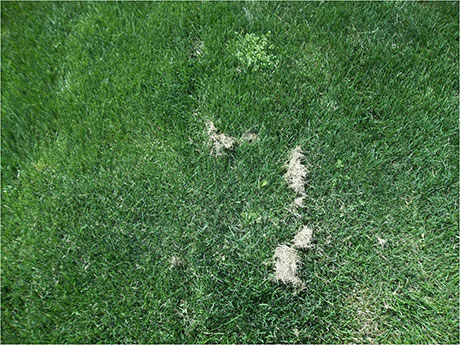
Photo credit: Joseph Heckman
A healthy lawn can be a beautiful asset to a home landscape and, when properly managed, can help reduce soil erosion and stormwater runoff. In an organic program, the goal for lawns is to reduce their size to what is absolutely necessary. Large lawns require a great deal of energy and resources to be maintained. Where a lawn is maintained, low maintenance turf grass varieties should be chosen that are adapted to the particular site conditions and intended use. Lawns should be mowed to maintain a height of 3 inches which helps to stimulate root growth and shade out unwanted weeds.
In addition, organic management considers lawn irrigation a nonessential use of water and should be kept to a minimum. Irrigation should be natural rainfall only except during initial turf establishment. The organic philosophy strives for a healthy lawn that is capable of going dormant to survive drought.
Grass clippings should be left on the lawn in order to cycle nutrients back into the soil. Incorporating nitrogen-fixing legumes such as white clover into a lawn is also beneficial for decreasing fertilizer applications. Nitrogen that is produced naturally through the use of clover is much less likely to leach from the soil then synthetic fertilizers.
An organic land care program should include assessing a site for where lawn is not necessary and lawn alternatives should be considered. These include native grass and wildflower meadows, pollinator strips, rain gardens, and low-maintenance perennial beds.
Native plants with different bloom times throughout the seasons can be added to the landscape to provide pollen and nectar for pollinators. When choosing native plants, remember "right plant, right place". Choose plants that will thrive in your local site conditions. Is your site sunny or shady? Is your soil wet or dry, sandy or clay? No matter your site condition there are native plants that will fit into your landscape. Ask your local garcen center to carry natives plants.
Here are some tips for incorporating native plants into your landscapes:
- Instead of buying annuals for pots and garden borders, think about incorporating native herbaceous perennials.
- Instead of buying annual fall mums, plant late flowering Asters or Goldenrods that flower from September into November. You’ll be supporting pollinators late into the season.
- If you look forward to crocuses coming up in the spring, consider planting early spring ephemerals like Virgina Bluebells (Mertensia virginica), Dutchman’s Breeches (Dicentra cucularilla), or Wild Geranium (Geranium maculatum).
- Use native plants as a groundcover, for example Golden Ragwort (Packera aurea), Wild Ginger (Asarum canadense), or Pennsylvania sedge (Carex pensylvanica).
- Use native shrubs as a hedge, for example Blackhaw Viburnum (Viburnum prunifolium).
- When selecting specimen trees, make sure they are native for example Swamp White Oak (Quercus bicolor) or American Hornbeam (Carpinus caroliniana).

